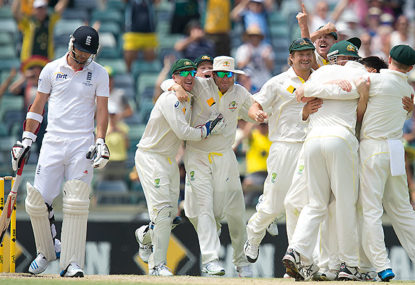The All Time XI For All Time: West Indies
Through electric bowling, dashing batting and acrobatic fielding the West Indies made themselves one of the most popular teams throughout history.

I’m still in a state of shock. Even though an Australian Ashes victory, heck even a clean-sweep, has virtually been inevitable since the middle of the Adelaide Test, I find myself bewildered the series is over before Boxing Day.
Removing fandom, which has slowly evaporated as I have matured (note, I use the term ‘mature’ loosely) part of me is disappointed the series has a) been completely lopsided – even 2006-07 was much more competitive at the parallel stage – and b) Boxing Day now has a hollow dead rubber stench to it.
There is no cricket equivalent to a throbbing MCG on Boxing Day during an important Test match.
No doubt the masses will attend and it will be a pulsating atmosphere, but the dead rubber loses some of its shine in my opinion. Alas!
Others were more bullish of Australia’s chances of reclaiming the Ashes pre-series but I must admit I didn’t see it coming.
I backed England mainly because of their obvious edge in solidarity. Plus England boasted four of the five most credentialed batsmen, had the best paceman and spinner.
Australia was relying on erratic players – David Warner, Shane Watson and Mitchell Johnson – for success. In other words, everything had to go right for Australia – who by the way hadn’t won a Test since January – to regain the Ashes.
It hasn’t even been close since day one at the Gabba, which was probably England’s only successful day so far.
England’s stars haven’t fired a shot – Alastair Cook’s burden has become unbearable, Kevin Pietersen is dumbfounded against Peter Siddle’s unnerving accuracy, Ian Bell’s golden touch has deserted him, James Anderson has lost his famed guile and menace, Graeme Swann has retired and Trott is back in England.
England’s inconsistencies during their home summer revealed they were on the downward curve but it was hard to imagine their descent would spiral so shockingly and suddenly.
Anyway, Australia deserves the praise they are receiving from a suddenly adoring public and press, which was ridiculing their every move during a previously turbulent period.
This demolition of a fancied England is the most unexpected turnaround in Australian cricket’s recent history, right?
The shortlist of unexpected Aussie success in modern times – World Cup ’87, Ashes ’89, West Indies ’95, South Africa ’09 – and that’s probably it? Where does this rank against those?
Personally, this Ashes romp, particularly if 5-0 eventuates as it should, rockets to the top of the list because of the sheer obliteration of a highly regarded and respected team.
Remember, Australia came into the series having not won a Test out of their previous nine attempts (seven losses) and their recent Ashes record was sobering – two wins (8 losses) from 15 matches.
Suddenly, they are going to clean-sweep the English? I keep thinking I’m about to wake up from this fantasy.
How the hell did this happen?
It’s amazing what can happen to a side (and hence the opposition) when they have enforcers opening the batting and bowling.
An in-form and aggressive Warner, who has finally materialised into being more than a parody of Matthew Hayden, and Johnson energised an Australian team that was gallant at times in England but lacked the punch to wound an experienced England.
And how did Brad Haddin morph into a game-changing player reminiscent of Gilly at his best? At 36 years of age? Has he been drinking from Mike Hussey’s anti-ageing potion?
But is this really the dawn of a new Australian era? Can this team realistically become the number one Test team?
Is this just fool’s gold akin to two years ago when they beat a similarly star-laden but morbid Indian team?
The bowling appears in good shape despite the strong possibility that Johnson never recaptures this sizzle and Harris (aged 34 with a battered body) may realistically only have a year or two left at the elite level.
Assuming they can stay clear from the injury scourge, Siddle, James Pattinson, Pat Cummins, Mitchell Starc and Jackson Bird ensure Australia’s pace stocks are strong, while Nathan Lyon continues to have a knack for producing key wickets, reinforcing his ‘under-rated’ tag.
The batting still stutters, and question marks remain. What are Rogers, Watson, George Bailey and Haddin’s (age will surely conquer eventually) fates? I still envision Watson as a number six.
I know, I know, he prefers starting against the hard ball and can be in a tangle against immediate spin. He’s getting older (aged 32), so it’s imperative to ensure his all-round ability can be maintained for the long haul.
His skilful and tight bowling in Adelaide and Perth reinforced my long-held belief that Watson is an under-rated bowler but an over-rated batsman.
Bailey had a jolly old time whacking Anderson to oblivion, when Australia’s batting morphed into a T20 impression early on day four.
But his struggles against quality consistent pace bowling (when England occasionally got it right) have been exposed during this series, and one wonders if he has the technique to survive against Dale Steyn, Vernon Philander et al in South Africa.
Silk should be Rogers’ successor at the top but when is the time to pass the baton? Phil Hughes seems destined for another crack at some stage.
He’s had an abundance of chances and seems to have regressed since his blazing induction to international cricket, but at still only 25 years of age, it would be folly to believe he can’t replicate Justin Langer, Hayden, Damien Martyn and carve out a successful career.
So, my batting-order for the short-medium term: Jordan Silk, Warner, Hughes, Michael Clarke, Steve Smith, Watson, Haddin/Tim Paine.